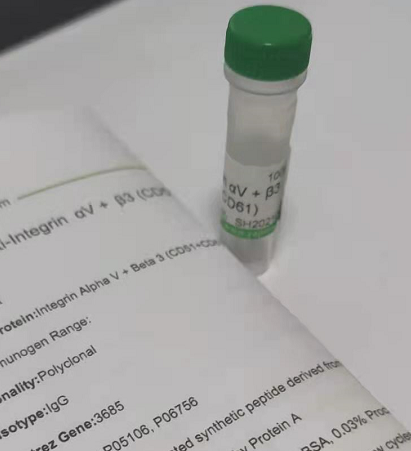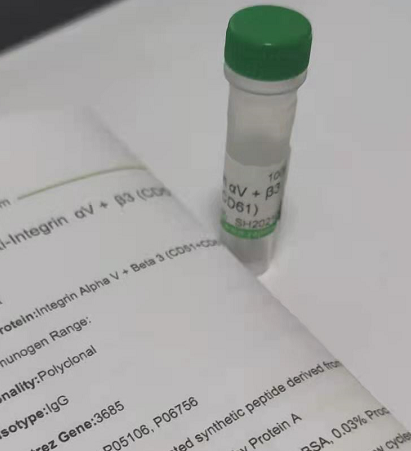| 產(chǎn)品編號(hào) | Ys-6558R |
| 英文名稱 | OLFM4 |
| 中文名稱 | 抗細(xì)胞凋亡蛋白OLFM44抗體 |
| 別 名 | Antiapoptotic protein GW112; G-CSF-stimulated clone 1 protein; GC1; GW112; hGC 1; hGC-1; hOLfD; olfactomedin 4; Olfactomedin-4; OlfD; OLFM4; OLFM4_HUMAN; OLM4. |
| 研究領(lǐng)域 | 腫瘤 腫瘤細(xì)胞生物標(biāo)志物 |
| 抗體來源 | Rabbit |
| 克隆類型 | Polyclonal |
| 交叉反應(yīng) | Mouse, Rat, (predicted: Human, Dog, Pig, Cow, Rabbit, ) |
| 產(chǎn)品應(yīng)用 | WB=1:500-2000 ELISA=1:5000-10000 IF=1:200-800 not yet tested in other applications. optimal dilutions/concentrations should be determined by the end user. |
| 理論分子量 | 55kDa |
| 細(xì)胞定位 | 細(xì)胞漿 細(xì)胞膜 細(xì)胞外基質(zhì) 分泌型蛋白 |
| 性 狀 | Liquid |
| 濃 度 | 1mg/ml |
| 免 疫 原 | KLH conjugated synthetic peptide derived from human OLFM4: 111-510/510 |
| 亞 型 | IgG |
| 純化方法 | affinity purified by Protein A |
| 緩 沖 液 | 0.01M TBS(pH7.4) with 1% BSA, 0.03% Proclin300 and 50% Glycerol. |
| 保存條件 | Shipped at 4℃. Store at -20 °C for one year. Avoid repeated freeze/thaw cycles. |
| 注意事項(xiàng) | This product as supplied is intended for research use only, not for use in human, therapeutic or diagnostic applications. |
| PubMed | PubMed |
| 產(chǎn)品介紹 | Olfactomedin-4, also known as G-CSF-stimulated clone 1 protein, Antiapoptotic protein GW112, and OLFM4, is a secreted protein which contains one olfactomedin-like domain. OLFM4 is expressed during myeloid lineage development. It is strongly expressed in the prostate, small intestine and colon and moderately expressed in the bone marrow and stomach. OLFM4 is highly expressed in pancreatic cancer tissues and shows an elevated expression level during the early S phase of the cell cycle. It is also expressed at high levels in stomach cancer and colon cancer tissues. Inhibition of ROS or the ERK pathway remarkably decreased G-CSF-induced OLFM4 expression. OLFM4 is an antiapoptotic factor that promotes tumor growth. OLFM4 promotes proliferation of pancreatic cancer cells by favoring the transition from the S to G2/M phase. OLFM4 also facilitates cell adhesion. Induction of OLFM4 in cancer cells was reported to have a novel antiapoptotic action via binding to the potent apoptosis inducer GRIM-19. The human OLFM4 is also thought to be a useful marker for early myeloid development. Function: May promote proliferation of pancreatic cancer cells by favoring the transition from the S to G2/M phase. In myeloid leukemic cell lines, inhibits cell growth and induces cell differentiation and apoptosis. May play a role in the inhibition of EIF4EBP1 phosphorylation/deactivation. Facilitates cell adhesion, most probably through interaction with cell surface lectins and cadherin. Subunit: Homomultimer; disulfide-linked. Interacts with NDUFA13. Interacts with cell surface lectins (locutions ricinus communis agglutinin I, concanavalin-A and wheat germ agglutinin) and cadherin. Subcellular Location: Secreted, extracellular space. Mitochondrion. Note=Subcellular location is not clearly defined: has been shown to be secreted (PubMed:16566923), but also in the mitochondrion (PubMed:15059901 and PubMed:20724538), cytoplasm and plasma membrane (PubMed:20724538) and in the nucleus (PubMed:15059901). Tissue Specificity: Expressed during myeloid lineage development. Much higher expression in bone marrow neutrophils than in peripheral blood neutrophils (at protein level). Strongly expressed in the prostate, small intestine and colon and moderately expressed in the bone marrow and stomach. Overexpressed in some pancreatic cancer tissues. Post-translational modifications: N-glycosylated. Similarity: Contains 1 olfactomedin-like domain. SWISS: Q6UX06 Gene ID: 10562 |
我要詢價(jià)
*聯(lián)系方式:
(可以是QQ、MSN、電子郵箱、電話等,您的聯(lián)系方式不會(huì)被公開)
*內(nèi)容:









